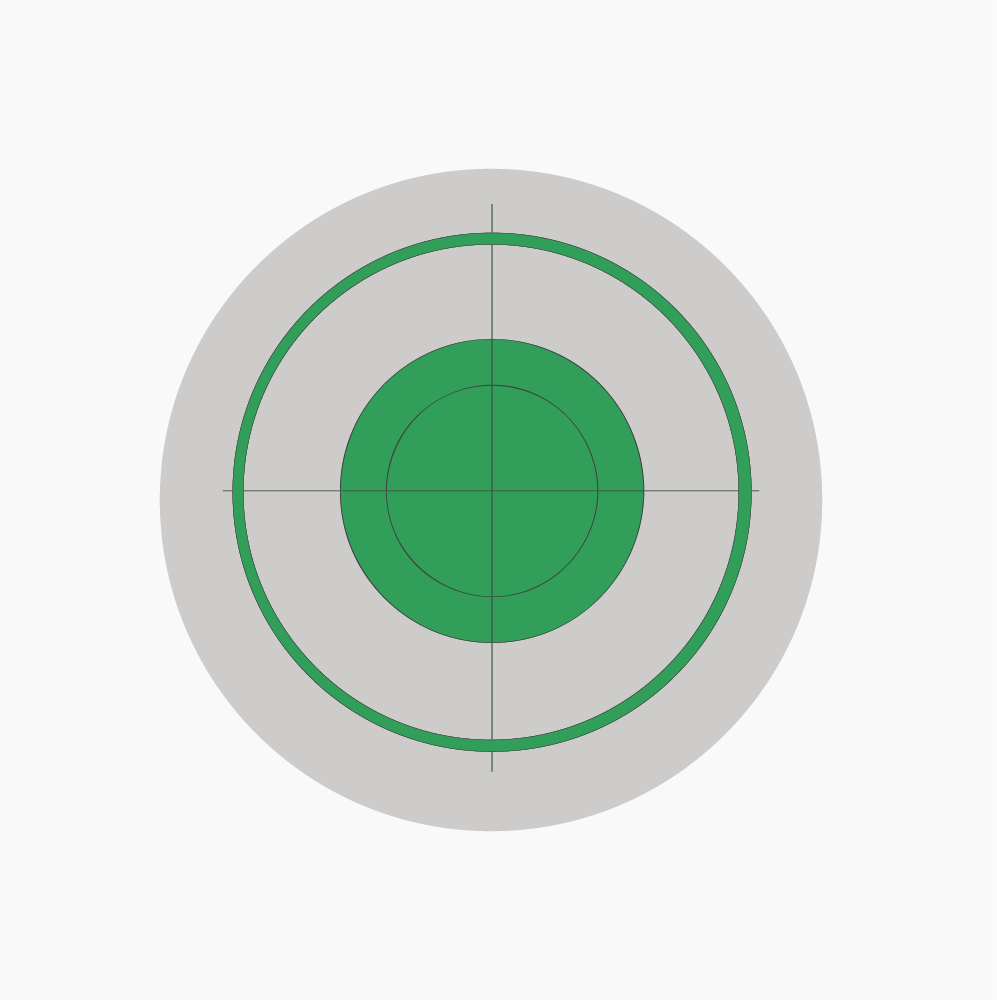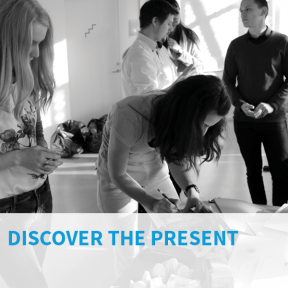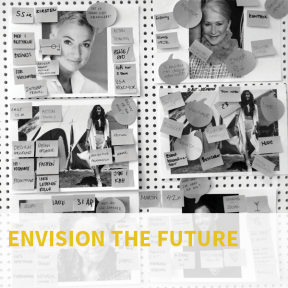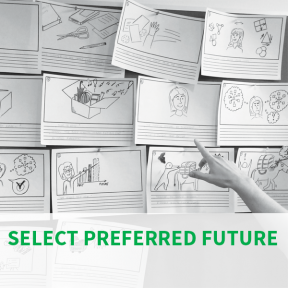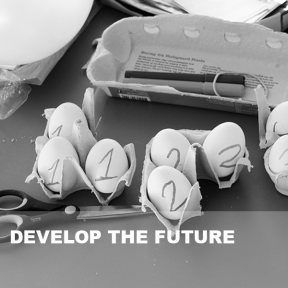Design teaching methods
The five outer factors of the DesUni model surrounding the student in the centre
In order to support and stimulate the student’s actions, imagination and mind-set (the inner elements), the outer elements of the DesUni model create a learning environment that assists teachers in constructing an educational setting in which students are likely to use their imagination, act and adopt a design-oriented mind-set in their work with the curriculum.
The five outer factors guide teachers in designing a design-oriented educational setting, with the intention of changing the student’s expectations from being passive receivers of theoretical knowledge, to becoming active creators of knowledge and primary agents in their own teaching process.
1. DESIGN METHODS
One of the five outer factors ‘Design Teaching Methods’ offers teachers novel teaching methods that make use of designer’s methods, tools and processes. They can be used to open, close and link students’ creative capabilities and convergent analytical skills. Because design can be seen as a specific approach to creative, wicked problem solving, DesUni learning is a specific approach to problem-based learning. The learning situation’s centre of rotation is a problem (often a ‘real-life’ problem) that is wicked. Wicked problems are challenging and cannot be tamed up-front. When students work with wicked problems, new problem and solution spaces are likely to emerge, and call for design methods in order to be solved. Tapping into the Des learning process, teachers can support students in solving wicked problems, and there from construct new knowledge (Figure 2).

Figure 2. The Des learning process
Each circle of the Des-learning process model has its own specific Design tools and methods following a division into the four circles.
1. The circle in the centre
The circle in the centre of the learning process highlights some fundamental guiding design principals of the DesUni universe in which the methods and tools of the three outer circles are grounded. The three guiding design principles are: The use of theory; Creation of representations, and Interaction with others.
The use of theory:
Des learning processes use theories as inspiration for discovering the problems, envisioning the future, and selecting/evaluating preferred futures. Theories are important inspirational sources for reaching fresh and alternative insights, interpretations or explanations of the problems, solutions and interlinks between them. Depending on the flow and content of the Des learning process, theories from different disciplines are likely to become relevant as sources of inspiration. Consequently, Des learning process is often about crossing theoretical traditions and creating new interdisciplinary links between theories. New theories or refined theories may be the result.
The creation of representations:
Roughly speaking, design is about creating things as visualizations, boundary objects, prototypes, mock-ups, etc. These objects are created and used as important steps on the way to solving a problem. Designers do not only talk about problems and solutions, they build them. Importantly, this makes it possible for others to interact with, and further develop, the new knowledge continually constructed in the Des learning process.
Interacting with others:
Key tasks within design processes are to interact with stakeholders associated with the problem space, and to co-create solutions together with (or with reference to) them. Design is about social interaction and co-creation, and thus throughout the Des learning process students’ interactions and emphatic engagement with stakeholders is essential. Interaction is therefore a key principle of Des learning processes. New knowledge is constructed from within the meeting between students and stakeholders associated with the problem space.
The inner circle of the Des learning process is supported by three different problem solving modes, which all include methods of using theory, creating representations and interaction with others. To solve wicked problems, teachers can facilitate students in moving in and out of three surrounding design principles:
1) Discovering the present; 2) Envisioning the future; 3) Selecting the preferred future; and 4)Develop the future. Each mode has its own methods and tools associated with it:
2. Discover the present
The circle concerns the creation of a deep insight into the problem space: essentially, to understand what is happening and what is the problem. This requires the gathering of data and information about the problem, in order to get closer to the problem. The methods are about understanding the problem, either through collecting or analysing data concerning what is already there.
See the methods here…
3. Envision the future
The circle is about generating a wide range of different and creative solutions to the problem. It is about ´thinking outside of the box’, to explore what might be future solutions to the problem space. Teachers are offered energizers to facilitate students in entering an ‘envisioning the future’ mode, as well as divergent methods and tools to generate a wealth of new solutions.
See the methods here…
4. Select the preferred future
The circle offers convergent idea selection and idea evaluation methods and tools. These support students in deciding which solution ideas to develop further, and to evaluate these potential solutions in the light of the problem space.
See the methods here…
5. Develop the future
The circle offers idea testing and idea implementation methods and tools. These support students in developing and testing prototypes as well as presenting and implementing ideas with people that are involved as users in the problem space.
See the methods here….
All the methods within the circles are split into two types of methods that are closely related to each other, as illustrated in the circles, and all the circles are, yet again, supported by the guiding principals that offer design methods placed in the centre Figure 3.
Figure 3. The DesUni methods
DesUni methods:
The logic underpinning the organisation of the DesUni methods circles is constructed in a space between Abstract and Concrete on the vertical axis and Reflection and Action on the horizontal axis, in a 2x2 matrix as illustrated in Figure 4.
Figure 4. Organisation of the DesUni methods
The logic of Reflection, Abstract, Action and Concrete as the dimensions behind the Des-learning process model follows the logic of other learning process models (e.g. Kumar, 2012; Kolb, 1985; Dubberly, 2008), which is illustrated in figure 5 as: Collect information, Analyse data, Idea development and Realisation of the idea.
Figure 5. The underlying structure of the DesUni Methods
The Des-learning process (Figure 2) can be structured as a circular progression following the orbit that connects the circles. First, students discover the present problem space, then they envision future solutions for the problem, and finally they select and evaluate the solution(s) they prefer. Alternatively, teachers may construct more iterative learning processes, involving many feedback loops and unpredictable shifts back and forth between the circles of the learning model, in order to solve the problem.
Since we are concerned about how to change the student’s expectations from those of being passive receivers of theoretical knowledge to becoming active creators of knowledge and primary agents in the teaching process, the majority of our Design-Thinking methods are therefore also developed in the part of the Des-learning process model that is concerned with action. However, this is not to say that the reflection part is less important. On the contrary, since most university teaching is developed around collecting and analysing data we have paid much more attention to offer method to activate students and to make reflective methods more design thinking orientated. Often the realisation of the idea is not a part of the university curriculum, and therefore learning methods for the realisation of student’s university ideas remain undeveloped.
Literature:
Kumar, V. (2012). 101 design methods: A structured approach for driving innovation in your organization. John Wiley & Sons.
Kolb, D. (1985). Learning styles inventory. The Power of the 2 2 Matrix, 267.
Dubberly, H., & Evenson, S. (2008). On modeling The analysis-systhesis bridge model. interactions, 15(2), 57-61.




